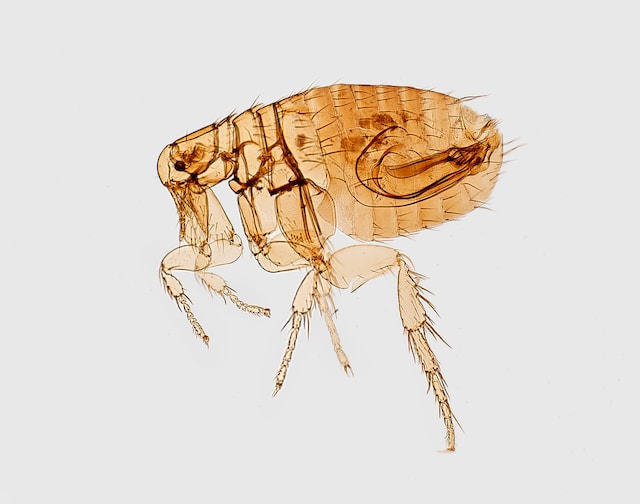Our pets are cherished members of our families, bringing joy, companionship, and unconditional love into our lives. Ensuring their health and safety is a top priority for responsible pet owners. Unfortunately, common pests can pose serious risks to our furry friends. In this comprehensive guide, we will explore the various pests that can harm pets, from fleas and ticks to mosquitoes and rodents. By understanding the risks and implementing preventive measures, pet owners can create a safer and healthier living environment for their beloved companions.

Bed Bugs and Pets
While bed bugs are commonly associated with human habitats, they can also affect our pets, causing discomfort and skin irritation. Bed bug infestations in homes may lead to bites on pets, contributing to skin problems and discomfort. Recognizing the signs of bed bugs, such as small reddish-brown bugs, white eggs, or dark fecal spots on bedding, is crucial for prompt intervention. In cases of bed bug infestations, seeking the expertise of pest control experts is essential. Professionals from https://ecopest.ca/ advise that addressing bed bug infestations requires professional pest control measures, as these pests can be challenging to eliminate. Professional pest controllers can assess the extent of the infestation, implement targeted solutions, and provide guidance on eliminating bed bugs effectively. Collaborating with pest control experts ensures a thorough and efficient approach to eradicating bed bugs from the home environment, protecting both humans and pets from these troublesome pests.
Fleas and Ticks
Fleas and ticks are notorious pests that can significantly impact the health and well-being of our pets. Fleas are tiny, blood-sucking insects that can infest a pet’s fur, causing incessant scratching, redness, and even allergic reactions. Ticks, on the other hand, can transmit serious diseases like Lyme disease to pets through their bites. Both pests thrive in outdoor environments and can quickly become a nuisance. Preventive measures are crucial to protect pets from these pests, including the use of veterinary-recommended medications and topical treatments. Regular grooming and thorough inspections after outdoor activities help pet owners identify and remove ticks promptly. By understanding the risks posed by fleas and ticks and implementing proactive preventive measures, pet owners can ensure their furry companions enjoy a healthier and more comfortable life.
Mosquitoes and Heartworm
Mosquitoes pose a unique threat to our pets as carriers of heartworm disease. When mosquitoes bite an infected animal, they can transmit heartworm larvae to pets through their bites. Heartworm disease is a serious and potentially fatal condition that affects the heart, lungs, and blood vessels of infected pets. Preventing mosquito bites is a key strategy to protect pets from heartworm disease, and this involves the use of preventive medications prescribed by veterinarians. Pet owners should be particularly vigilant during mosquito season, ensuring their pets are kept indoors during peak mosquito activity and using mosquito repellents designed for pets when necessary. By understanding the connection between mosquitoes and heartworm disease and taking proactive measures, pet owners can significantly reduce the risks associated with this potentially devastating illness.
Rodents and Their Impact
Rodents, such as mice and rats, can bring various health risks into homes, affecting both humans and pets. These pests may carry diseases that can be transmitted to pets through bites or contact with their urine and feces. Securing homes to prevent rodent access is crucial. This includes sealing entry points, storing pet food securely, and utilizing rodent traps or professional pest control services when necessary. By eliminating potential rodent infestations, pet owners can reduce the risks associated with these pests.
Ticks and Lyme Disease
Ticks are not only a nuisance but also carriers of diseases such as Lyme disease. Pets that spend time in wooded or grassy areas are particularly vulnerable to tick bites. Recognizing the symptoms of Lyme disease, such as lameness, joint swelling, and lethargy, is crucial for early intervention. Tick prevention strategies, including regular checks and the use of tick repellents, play a key role in protecting pets from this potentially debilitating condition.
Flea Allergy Dermatitis
Flea allergy dermatitis is a common skin condition in pets, resulting from an allergic reaction to flea saliva. Even a few flea bites can trigger intense itching and discomfort in allergic pets. Recognizing the symptoms, such as excessive scratching, hair loss, and skin irritation, is essential for effective treatment. Treating flea allergy dermatitis involves not only eliminating fleas on the pet but also addressing flea infestations in the home environment. Veterinarian-recommended flea control products and diligent household cleaning are crucial components of managing and preventing this condition.
Prevention Tips for a Pest-Free Home
Preventing pest infestations involves a combination of regular veterinary check-ups, preventive medications, and maintaining a clean living environment. Regular veterinary check-ups not only ensure that pets are in good health but also allow veterinarians to recommend and prescribe appropriate preventive medications. These medications can include treatments for fleas, ticks, heartworm, and other common pests. Maintaining a clean home involves regular vacuuming, washing pet bedding, and practicing good hygiene to reduce the likelihood of pest infestations.
Professional pest control measures and consultation are crucial components of a comprehensive pest prevention strategy. Pest control experts can assess the home, identify potential risks, and implement targeted solutions to eliminate and prevent pest infestations. Regular consultations with pest control professionals are particularly valuable in homes with a history of pest issues or in regions where certain pests are prevalent.
Outdoor Pests and Hazards
Outdoor pests can also pose risks to pets, especially those with a penchant for exploring the great outdoors. Identifying potential outdoor threats, such as poisonous plants, venomous animals, and pest habitats, is essential for ensuring pet safety. Landscaping practices that minimize pest habitats and hazards, coupled with proper pet supervision, contribute to a safer outdoor environment. Educating pet owners on outdoor safety measures and potential hazards empowers them to create a secure outdoor space for their pets.

In conclusion, understanding the common pests that can harm pets is crucial for responsible pet ownership. Fleas, ticks, mosquitoes, rodents, and other pests pose various health risks to our beloved companions. By identifying these pests, recognizing the signs of infestation, and implementing preventive measures, pet owners can create a safer and healthier living environment for their furry friends. Regular veterinary care, preventive medications, and professional pest control are integral components of a comprehensive pest management strategy. By prioritizing pet health and safety, we can ensure that our pets thrive in pest-free homes and enjoy long, happy, and healthy lives.
